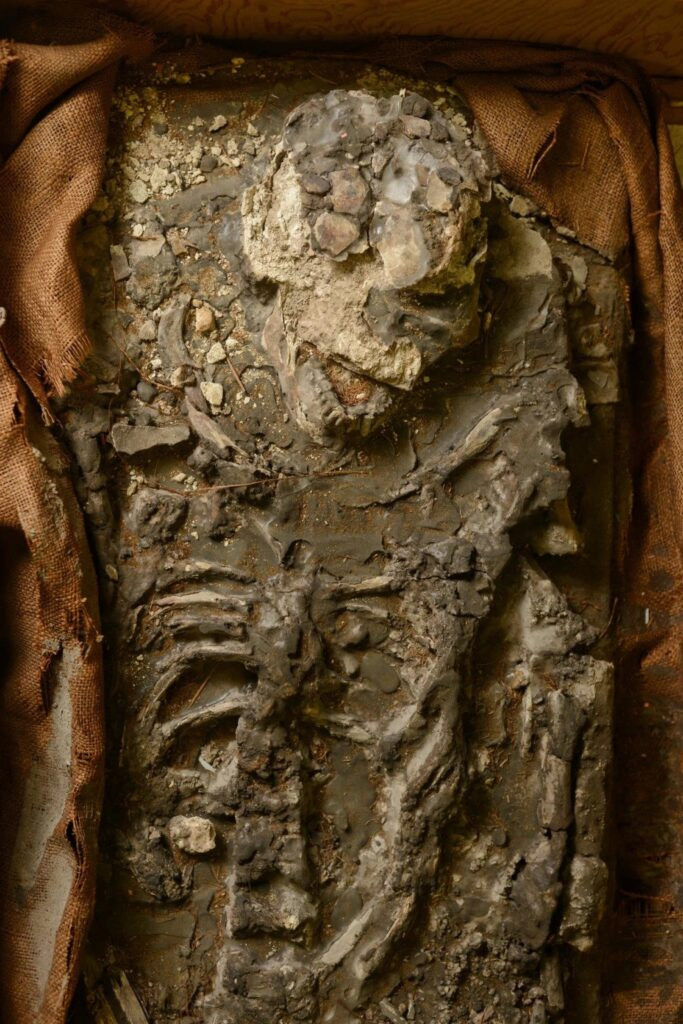In the basement of the Penn Museum in Philadelphia, an extraordinary discovery was uncovered—a 6,500-year-old human skeleton, affectionately named “Noah.” This ancient relic had been lying undisturbed in a wooden box for 85 years, forgotten amidst the museum’s vast collection. The skeleton, originally excavated by Sir Leonard Woolley during his renowned archaeological work at the site of Ur in modern-day Iraq between 1929 and 1930, had been considered lost until its rediscovery brought new intrigue to the field of archaeology.
Sir Leonard Woolley’s excavations at Ur are celebrated for their groundbreaking findings, including the famous Mesopotamian “royal cemetery,” which contained hundreds of graves and 16 spectacular tombs filled with cultural artifacts. These artifacts offered invaluable insights into the lives and customs of the ancient Mesopotamian civilization. However, Woolley and his team also uncovered something even older during their meticulous excavations—graves predating the royal cemetery by an astounding 2,000 years, hinting at an even deeper historical significance for the region.

Among these ancient burials was a collection of graves belonging to the Ubaid period, a prehistoric era that stretched from roughly 5500 B.C. to 4000 B.C. The Ubaid period is a cornerstone of Mesopotamian history, representing one of the earliest known phases of settled agricultural societies in the region. Woolley and his team, digging nearly 50 feet (15 meters) below the surface of Ur, discovered 48 graves from this period. The remarkable preservation of these graves provided a rare glimpse into the lives of people who lived over 6,000 years ago.
Recognizing the extraordinary value of these finds, Woolley decided to preserve a single skeleton from the Ubaid graves for further study. In an effort to ensure its safe transport and preservation, he coated the bones and surrounding soil in wax, carefully boxed the remains, and arranged for them to be shipped first to London and later to Philadelphia. This meticulous process safeguarded the skeleton, but over the decades, it was misplaced within the vast collections of the Penn Museum and largely forgotten—until its rediscovery.
The rediscovery of this ancient skeleton, now affectionately nicknamed “Noah,” was set in motion by William Hafford, the project manager tasked with digitizing the Penn Museum’s extensive records. While reviewing historical documents, Hafford came across a perplexing reference to two skeletons from Woolley’s excavation being shipped to the museum. However, only one skeleton had been documented and displayed, raising questions about the whereabouts of the second.
Curious and determined, Hafford reached out to Janet Monge, the curator of physical anthropology at the museum, who remembered seeing a mysterious wooden box in the museum’s basement. This box, long overlooked and gathering dust, was eventually opened, revealing the long-lost remains of the second skeleton. The discovery was nothing short of extraordinary, reigniting interest in the ancient history of the Ubaid period and its connection to the broader story of Mesopotamian civilization.
With the skeleton now in their possession, the Penn Museum’s researchers embarked on a new journey to uncover the secrets hidden within “Noah.” Modern scientific techniques, such as isotope analysis and DNA testing, offer an unprecedented opportunity to delve into the life of this ancient individual. By analyzing the skeleton’s bones and teeth, researchers hope to uncover critical details about the person’s diet, ancestry, health, and living conditions. These findings can provide valuable insights into the broader Ubaid society and its development as one of the earliest known agricultural communities.
Additionally, the site of Ur, where the skeleton was originally discovered, holds significant cultural and historical importance. The region is famously linked to the story of a great flood, often associated with the biblical tale of Noah’s Ark. While it is impossible to establish a direct connection between this ancient individual and the flood narrative, studying the environmental conditions and archaeological context of the site could help researchers understand the realities of life during a time when such events may have influenced local communities.
The rediscovery of “Noah” is more than just a story about finding a misplaced artifact—it is a testament to the enduring value of archaeological research and the importance of preserving historical records. The meticulous work of Woolley and his team nearly a century ago laid the foundation for this modern exploration, demonstrating how the careful documentation and preservation of artifacts can yield new discoveries long after the initial excavation.
For researchers and history enthusiasts alike, the story of “Noah” is a powerful reminder of the interconnectedness of human history. By piecing together the fragments of our past, we gain a deeper understanding of our shared heritage and the remarkable journey of human civilization. The study of this 6,500-year-old skeleton not only sheds light on the lives of individuals from the Ubaid period but also highlights the enduring human spirit and its capacity to adapt, innovate, and thrive across millennia.
As the Penn Museum continues its analysis of “Noah,” the findings will undoubtedly contribute to our knowledge of ancient Mesopotamian societies and their role in shaping the modern world. This rediscovery underscores the importance of museums, not just as repositories of artifacts, but as dynamic institutions where history comes alive through ongoing research and exploration.
The story of “Noah” is a compelling chapter in the broader narrative of human history, blending meticulous archaeological work, cutting-edge science, and a touch of serendipity. It is a reminder that even the most seemingly forgotten relics can hold immense value, waiting patiently to reveal their secrets to those willing to look. Through the efforts of dedicated researchers and the power of modern technology, the ancient past continues to speak to us, offering lessons, insights, and a deeper appreciation for the rich tapestry of human experience.





